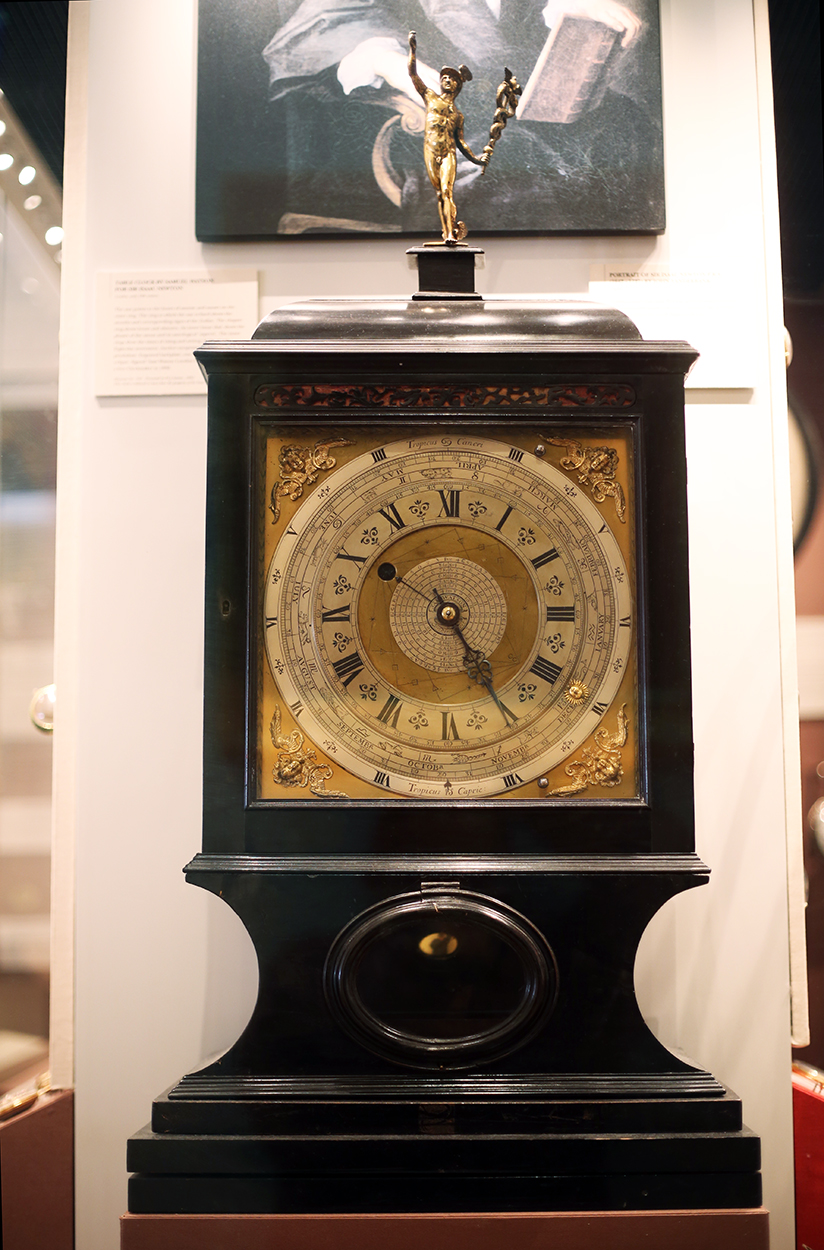
Although time and its measurement is a fundamental component of human life, a special type of clock which takes matters to the next level is the so-called
astronomical clock and whose purpose is not to measure time per se but to convey astronomical information and, in particular, the relative position of the
Sun and Moon as well as the zodiacal constellations and, in some cases, the position of the planets all as a function of time.
The oldest such effort to effectively emulate the overhead celestial sphere (ie a mini-planetarium) is the
Antikythera Mechanism which was discovered in 1901 totally by
accident by sponge divers off the coast of the Greek island of Antikythera. It has been dated to approximately 80 BC and it is believed to be the work of
Poseidonius of Rhodes. The Antikythera Mechanism is currently on display
at the National Archaeological Museum in Athens, Greece.
Note: The astronomical table clock below and on display at The Clockmakers' Museum in London, England, is believed to have been
owned by Sir Isaac Newton. The clock was made by the horologist Samuel Watson (1635-1710) and who is also credited wirh the construction of the first stopwatch in
1695 geared for physician use and which had an accuracy of 0.2 seconds.
The astronomical clock below is enclosed in a wooden case (ebony in colour) with a gold-plated statue of Mercury at its top and is comprised of various circular
rings. The outer ring, 11 inches in diameter, displays the time for sunrise and sunset using a gold-plated ball for the Sun and which makes one complete
rotation every 365 days in a clockwise direction. This ball is attached to a second smaller ring which is engraved with the Roman numerals I through 12, thus
denoting the months of the year accompanied with English text for the names of the months as well as demarcations for the number of days in each month. A consequent
inner ring depicts the associated zodiacal constellations beginning with Aries (The Ram) for the first month and concluding with Taurus (The Bull) for the twelveth
month. The hour of day is denoted using the Roman numerals I through XII and depict a 12-hr format with demarcations at 15-minute intervals with fleur-de-lis marking
midhour. A brass lunar dial is used to represent the 29.25-day period of the Moon with a coin-sized circle indicating the current lunar phase. The next brass dial
contains various radiant vectors to describe trine, quadrature, sextile and opposition of the Moon and similar to what was used with the astronomical clock at
Brescia captured a few months earlier. Finally, a set of
seven concentric finer rings at the center of the clock are used to describe the time of moonrise and moonset each month.
The Clockmakers' Museum is located on the second floor of The Science Museum of London and admission is free. An online reservation for a free ticket is not only
highly adviseable but ensures immediate entrance and without any need to stand in queue. The hours of operation of both museums is 10:00 to 18:00 and a few hours
will easily keep the visitor highly engaged. The metro station "South Kensington" has an underground tunnel approximately 750 meters in length and which leads to
the proper entrance above ground and about 20 meters to one's right as they exit the tunnel.
Note: For a zoomed-in view of the clock using greater focal length, please click
here.
Note: For additional results involving astronomical clocks from around the world, please click
here.
|
Body: Sun Mass: 332,900 x Earth Mass Eq Diameter: 109.1 x Earth Distance: 149 million km RA / Dec: 23h 41m 41s / +89° 19' 51" Diameter: 32.16' Magnitude: -26.8 |
 |
Date: Nov 30, 2023 Location: The Science Museum, London, England Equipment: Canon EOS 6D Baader BCF2 Filter Canon EOS EF 50mm/f1.8 USM @ f2.0 Exposure: 1 x 1/50 sec ISO 800 JPG Fine Image Format 5472x3648 Image Size Custom White Balance Continuous Servo Mode Manual Mode Software: Photoshop CS6 Processing: White Balance Adjustment Resampling JPG Compression |